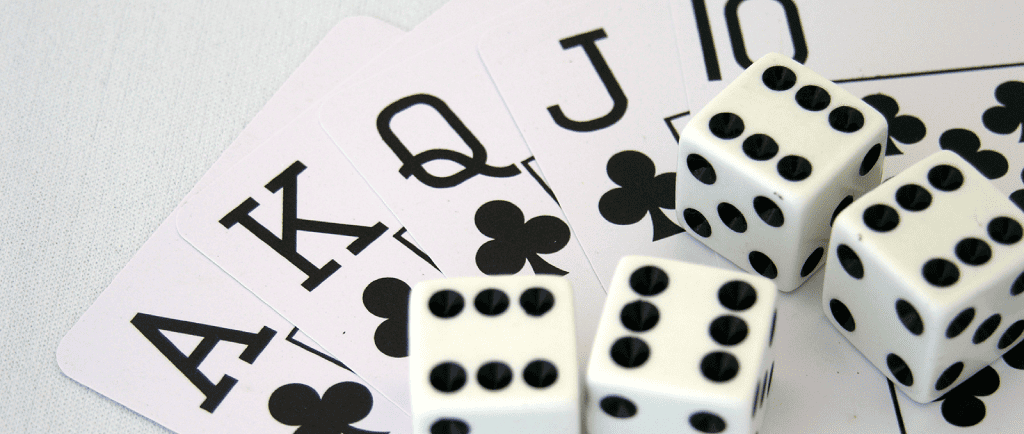
When I started this series on basic game elements, I hadn’t considered space or time. But a helpful suggestion from a reader reminded me of space, and time was a natural extension. Today I’ll discuss how space and time fit into games.
In case you missed the other Game Elements articles, you can find them here: Goals, Scoring, Actions, Resources, and Uncertainty.
PHYSICAL SPACE AND TIME
Before delving into space and time in games, it’s worth mentioning that all games take real space and time. When players commit to playing a game, they’re committing to spending a certain amount of time playing, time they will never get back. And all games take up some amount of space. This can vary drastically from game to game, from epic, sprawling war games that require multiple tables to compact games like Oddball Aeronauts that require no table space at all.

Oddball Aeronauts takes so little space it can be played without a table.
How much time should your game take? What’s an acceptable amount of space? That will depend a lot on the type of game you’re making. A simple card game should not take a lot of time or space, but a 4X space opera should.
In general, games that take less time and less space will get played more. Bigger, longer games can be appealing, but I recommend erring on the side of more compact and shorter.
GAME TIME
All games involve some form of time. Some use real continuous time, but most use discrete time, like turns or actions. I’ve already discussed a lot of the issues related to time in the Game Elements article on actions, so I won’t dwell on it here. However, I do want to offer a couple of suggestions related to time in games.
First, it’s generally a good idea to include a clock in your game. Note that clocks in games are often not themed as time: maybe you’ll go through a deck over the course of the game, or players will slowly lose hit points over time, or they’ll play a fixed number of turns. Whatever form your clock takes, a game tends to get played more when its play time is consistent, and some mechanism to ensure that a game doesn’t go on forever is key for this. In particular, it’s important that the clock never ticks backward; make sure the game is always marching towards a conclusion.
Second, time can play a central mechanical role in a game. This is a bit more difficult to do in tabletop games than in digital games where the computer can handle a lot of the grunt work (think Braid), but if you can keep it simple enough, time mechanics can be extremely interesting. Games like Thebes feel fresh because of the unique way they handle time. I think time travel is a particularly interesting concept that hasn’t been well executed mechanically (though prove me wrong in the comments!). If you’re looking to design a compelling new game, this is a potentially fruitful area to explore. Just make sure you keep it more fun than work.
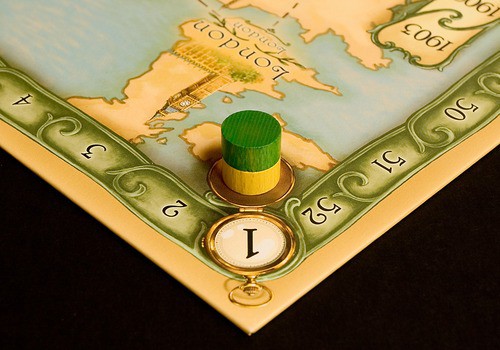
Thebes uses a novel time mechanic to determine player order.
GAME SPACE
Real space. Just as some games use real time, some games use real space, but it isn’t common. Miniature war games and dexterity games are among those that use real space, but there’s no reason it can’t be used in other types of games, where it can add a little novelty (String Railway comes to mind). Just remember that using real space can be more difficult to control and can result in more disagreements and edge cases.
Discrete space. Most games with a spacial component use discrete, abstract space. Game pieces can be in a finite number of locations, and there are explicit rules for how they can interact with other locations.
While games that feature space may look very different, they ultimately all boil down to graphs. For those unfamiliar with graph theory, the basic idea is that a graph is a collection of nodes connected by edges. A node is a location (a country in Risk, a city in Pandemic, etc) and an edge is a link between two nodes (country borders in Risk, paths in Pandemic, etc). There are lots of variants to this (weighted edges, like routes in Ticket to Ride; one-way edges, like in Tokaido; dynamic edges, like in Forbidden Desert), but discrete space in all games can be represented in this way.
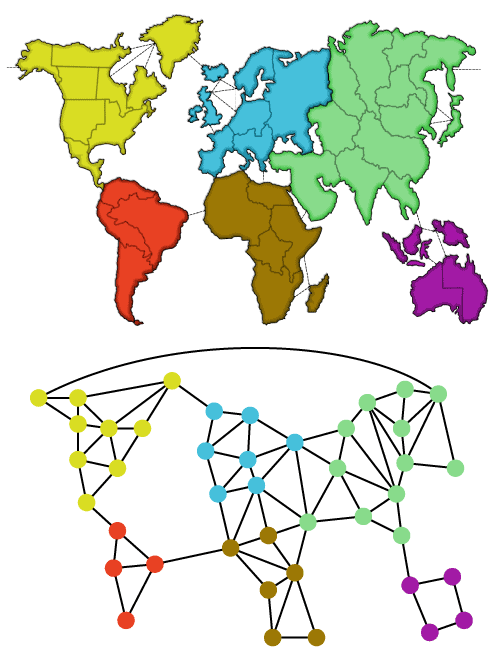
The Risk board as it’s presented to players and as a graph.
Why think of discrete spaces as graphs? For one thing, a lot of research has been done on graphs, which you might be able to leverage to better understand space in your game. For another, some of the variants on graphs could inspire novel and interesting mechanics.
Finally, graphs can be a great way to help you analyze space in your game. Patterns begin to pop out when you start looking at graphs, and they can help you evaluate how a particular space will play. For example, clusters are groups of nodes that have lots of edges to each other; it’s easy to get from one node to another in a cluster. Choke points, on the other hand, are narrow passages between clusters; they can be used to focus action and create strategically important areas. A dead end is a node or small cluster with few edges out, which can create strange edge cases or interesting tactical considerations.
Even if you present the space to your players in a very different way, looking at the space abstractly as a graph can help you identify imbalances and potential weaknesses in your map.
Structured space. Graphs are a very general purpose way of representing space and can easily handle irregular maps. But many games have rigid structures to their space, often square or hex grids. There are a number of advantages to structured spaces. They allow you to incorporate patterns, like the way pieces move in Chess or the shapes of pieces in Patchwork. Structured spaces can also be conceptually easier for people to understand than irregular space.
DOES YOUR GAME NEED SPACE?
Unlike time, not all games include some internal version of space, even when they might seem like they do. Citadels is a good example of this. In the game, players build up a city, but there is no real space in the game, as ordering, adjacency, and positioning make no difference. A lot of games, card games in particular, are like this.
So, whenever you work on a new game, ask yourself if it really needs space or not. Often times designers will add something like a board without having a good reason for it, and it simply complicates or slows down a game that would be perfectly fun without it. Even when a game seems like it needs space, I encourage you to always question its inclusion. What is space really adding to the experience?
Of course, there are good reasons to include space in a game. Below I’ll list a few of them.
The theme demands it. Some themes just cry out for some representation of space, like games about trade networks or military campaigns. Still, I think it’s always worth questioning the thematic justification, as many themes that seem like they would need space actually don’t.
Include spacial puzzles. Human brains have developed the ability to process spacial information over millions of years, and exercising that part of the brain can be pretty fun. By including space in a game, you create the opportunity to let people play with and find the joy in space.
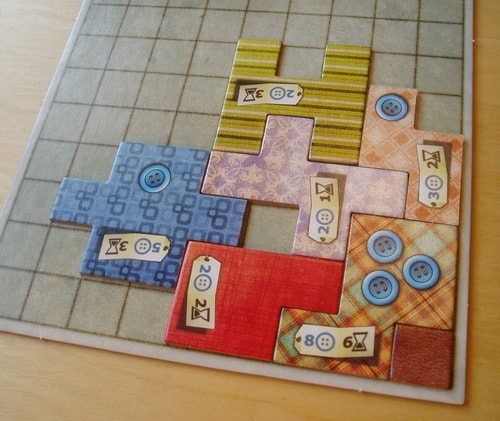
Part of the fun of Patchwork is in solving spacial puzzles.
You need a little more complexity. Some games just need a little something extra. Adding space can be a good way to do that without boggling the minds of your players.
Support more tactical gameplay. Space can greatly increase the amount of tactics involved in a game, because even when the same combination of game pieces are encountered multiple times, the different configurations they are found in can make each encounter feel different and interesting.
Differentiate game pieces and players. Making a piece move differently, or a different size or shape, can make it feel completely different. Similarly, players can feel very different when they control different parts of a map, either because of their spacial relationship to each other or because of different features of the map.
Focus interaction. Interaction is essential for multiplayer games, and space can be a great way to ensure interaction. Racing or fighting for control over different parts of a shared map is a tried and true way to get players to worry about each other.
Manage pacing. When players start in one place, then expand to another, space can form the backbone of the game’s experience arc.
Aesthetics. Visual appeal is a big draw of many games, and including space is a good excuse to add a lot of cool looking stuff. Visual appeal is especially strong when players modify the space over the course of the game, letting players create a shared masterpiece.
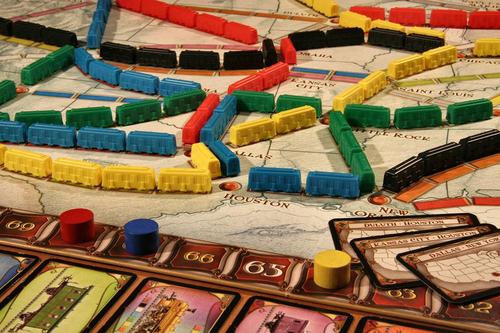
Part of the fun of Ticket to Ride comes from watching beautiful patterns emerge on the board.
ALL THE DIMENSIONS
Time and space are fundamental to the human experience, so it’s no surprise that they both make their way into games. But it’s useful to understand how they fit and whether they’re needed or not. Games always take time and space, and all games incorporate some form of time, but not all games include a representation of space. While there are lots of advantages to using space, it does add complexity, so it’s always worth questioning its inclusion. Make sure you know why space is in your game!
That’s all I have to say about space and time. But they’re big topics, and I’m sure I missed something. Please feel free to chime in in the comments. What other considerations do you make about space and time when designing games? What games use space and time in interesting and innovative ways?

